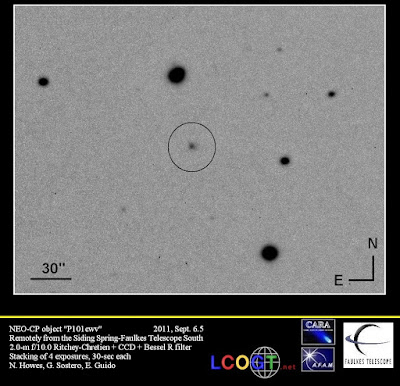Stacking of 9 R-filtered exposures, 120-sec each, obtained remotely, from the
Siding Spring-Faulkes Telescope South on 2011, September 20.6, through a 2.0-m f/10.0 Ritchey-Chretien + CCD, shows that
fragment b of comet 213P is still visible, albeit very faint and diffuse (m2 about 21.5, coma diameter about 5-arcsec). Fragment b was located about 5.7 arcmin in PA 240 respect the main nuclear condensation of 213P/Van Ness.
During the same observing session, we noticed also the presence of a new fragment, not visible on our past images obtained with the same set-up (the last of which dates back 2011, Sep. 2.5): this additional fragment (that we called below "part-y") appears slightly brighter and compact than 0213Pb itself (m1 about 21.0, coma diameter about 4-arcsec elongated toward the southwest). "part-y" was located about 4.5 arcmin in PA 239 respect the main nuclear condensations of 213P/Van Ness.
Our image of Sept. 20.6 about these fragments is available here:
Click on the thumbnail below to see a short animation showing the fragment's motion:
We obtained additional follow-up through the same instrumentation on 2011, Sep. 21.6, confirming the existence of both fragments b and "part-y". Further inspection of our images, exclude the presence of other fragments brighter than magnitude R about 22, up to 12-arcmin tailward of 213P.
UPDATE - SEPTEMBER 23, 2011
Stacking of 11 R-filtered exposures, 120-sec each, obtained remotely, from the Siding Spring-Faulkes Telescope South on 2011, September 23.6, through a 2.0-m f/10.0 Ritchey-Chretien + CCD, shows that fragment b of comet 213P/Van Ness is now extremely weak and diffused (uncondensed coma about 7-arcsec in diameter) that hampers any astrometric measurement about it (however this might be a temporary disappearance, as sometimes happens with these small cometary fragments in rapid evolution).
On today's images we found again the fragment we reported first on 2011, Sep. 20.58846 (at that time we called it "part-y").
Click on the thumbnail below to see a short animation showing the fragment's motion:
by Giovanni Sostero, Ernesto Guido & Nick Howes
















